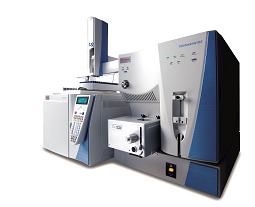Members Login

Channels
Special Offers & Promotions
Thermo Fisher Scientific Delivers New Triple Quadrupole GC/MS/MS Method to Facilitate Highly Selective Trace-level Screening of PCDD/Fs and PCBs
 Thermo Fisher Scientific Inc., the world leader in serving science, today announced a new method for the trace-level screening of polychlorinated dioxins/furans (PCDD/Fs) and polychlorinated biphenyls (PCBs) in food products, following the analytical strategy of the well established U.S. Environmental Protection Agency (EPA) Method 1613A. The newly launched Thermo Scientific TSQ Quantum XLS triple quadrupole gas chromatography tandem mass spectrometry (GC/MS/MS) instrument can reliably analyze PCDD/Fs and PCBs in foodstuff at the maximum residue levels (MRLs). The new method is described in an application note, entitled "PCDD/F Screening at the Maximum Residue Level for Food Safety Analysis using Highly Selective Triple Quadrupole GC/MS/MS," which is available to download via www.thermoscientific.com/pcdd.
Thermo Fisher Scientific Inc., the world leader in serving science, today announced a new method for the trace-level screening of polychlorinated dioxins/furans (PCDD/Fs) and polychlorinated biphenyls (PCBs) in food products, following the analytical strategy of the well established U.S. Environmental Protection Agency (EPA) Method 1613A. The newly launched Thermo Scientific TSQ Quantum XLS triple quadrupole gas chromatography tandem mass spectrometry (GC/MS/MS) instrument can reliably analyze PCDD/Fs and PCBs in foodstuff at the maximum residue levels (MRLs). The new method is described in an application note, entitled "PCDD/F Screening at the Maximum Residue Level for Food Safety Analysis using Highly Selective Triple Quadrupole GC/MS/MS," which is available to download via www.thermoscientific.com/pcdd.
PCDD/Fs and PCBs are among the most hazardous toxic contaminants of food and feed. Legislative agencies worldwide have successfully enforced MRLs for PCDD/F and PCB contaminants in foodstuff and specified screening and confirmation methods, which has helped reduce contamination in food. However, an increasing number of regional accidents with global impact have caused elevated levels of PCDD/Fs and PCBs in food products over the last few years. Requirements on the performance of analytical methods are regulated by providing identification points to analytical techniques and their combinations. Triple quadrupole GC/MS/MS has become a standard analytical method for priority pollutants in food, overcoming false positive results of bioassays with high selectivity from MS/MS selected reaction monitoring (SRM) and reliable target compound quantitation at the required low trace levels.
This method, which incorporates the TSQ Quantum XLSTM triple quadrupole GC-MS/MS with a Thermo Scientific Trace GC Ultra gas chromatograph, enables regulatory compliance for the trace-level screening and quantitation of PCDD/Fs and PCBs in foodstuffs. It follows the EPA Method 1613A measurement protocol, which uses isotope dilution quantitation with 13C-labeled internal standards. Using highly selective precursor ion selection and high-precision hyperbolic quadrupole technology available with the TSQ Quantum XLS, superior and uniform selectivity for screening for PCDD/Fs and PCBs at imposed MRLs in complex matrices is possible.
In addition, for the fast control of food samples, the new method offers five identification points, exceeding the minimum of four identification points required by European Union requirements. It also covers the injected range at and above 100fg absolute amount per compound. Positive screening results and a small subset of negative results must be verified by a confirmatory method of analysis, typically by high-resolution mass spectrometry (HRMS). Modern HRMS systems, including the Thermo Scientific DFS high-resolution GCMS, are capable of providing confirmatory results down to the very low femtogram level.
The TSQ Quantum XLS features a Thermo Scientific Durabrite IRIS ion source that delivers extremely high sensitivity with low femtogram-range limits of detection and unrivaled performance in GC/MS/MS structure selective detection for multi-component target compound quantitation. Offering superior flexibility, high-speed data acquisition and increased sample runs, the system is designed to considerably improve laboratory efficiency. The TSQ Quantum XLS provides a highly productive and accurate screening solution for increased sample throughput in food safety, contract and governmental control laboratories.
For more information on the new method and the Thermo Scientific TSQ Quantum XLS triple quadrupole GC/MS/MS, please call +1 866 463 6522 or visit www.thermoscientific.com/gc
Thermo Scientific is part of Thermo Fisher Scientific, the world leader in serving science.
Media Partners


